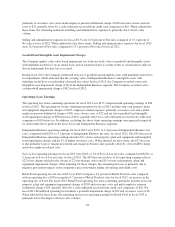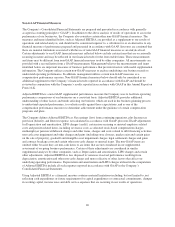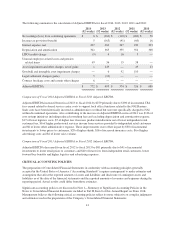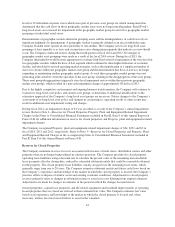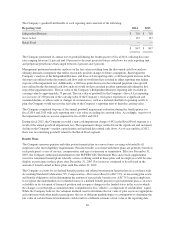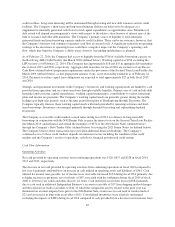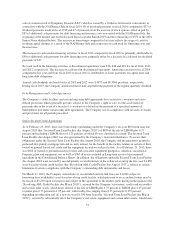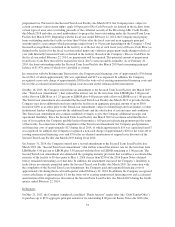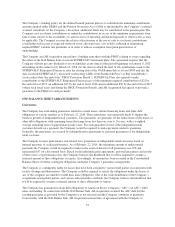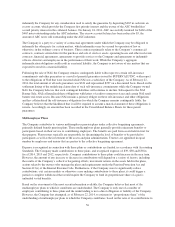Albertsons 2014 Annual Report Download - page 50
Download and view the complete annual report
Please find page 50 of the 2014 Albertsons annual report below. You can navigate through the pages in the report by either clicking on the pages listed below, or by using the keyword search tool below to find specific information within the annual report.The Company’s effective tax rate is influenced by tax planning opportunities available in the various
jurisdictions in which the Company operates. Management’s judgment is involved in determining the effective
tax rate and in evaluating the ultimate resolution of any uncertain tax positions. In addition, the Company is
currently in various stages of audits, appeals or other methods of review with taxing authorities from various
taxing jurisdictions. The Company establishes liabilities for unrecognized tax benefits in a variety of taxing
jurisdictions when, despite management’s belief that the Company’s tax return positions are supportable, certain
positions may be challenged and may need to be revised. The Company adjusts these liabilities in light of
changing facts and circumstances, such as the progress of a tax audit. The effective income tax rate includes the
impact of reserve provisions and changes to those reserves. The Company also provides interest on these
liabilities at the appropriate statutory interest rate. The actual benefits ultimately realized for tax positions may
differ from the Company’s estimates due to changes in facts, circumstances and new information. As of
February 22, 2014 and February 23, 2013, the Company had $76 and $187 of unrecognized tax benefits,
respectively.
The Company records a valuation allowance to reduce the deferred tax assets to the amount that it is more-likely-
than-not to realize. Forecasted earnings, future taxable income and future prudent and feasible tax planning
strategies are considered in determining the need for a valuation allowance. In the event the Company was not
able to realize all or part of its net deferred tax assets in the future, the valuation allowance would be increased.
Likewise, if it was determined that the Company was more-likely-than-not to realize the net deferred tax assets,
the applicable portion of the valuation allowance would reverse. The Company had a valuation allowance of
$1,356 and $1,358 as of February 22, 2014 and February 23, 2013, respectively.
Included in discontinued operations is the recognition of the additional tax basis in the shares of NAI offset by a
valuation allowance on the estimated capital loss, as there is no current evidence that the capital loss will be used
prior to its expiration.
Self-Insurance Liabilities
The Company uses a combination of insurance and self-insurance for workers’ compensation, automobile and
general liability costs. It is the Company’s policy to record its self-insurance liabilities based on management’s
estimate of the ultimate cost of reported claims and claims incurred but not yet reported and related expenses,
discounted at a risk-free interest rate.
In determining its self-insurance liabilities, the Company performs a continuing review of its overall position and
reserving techniques. Since recorded amounts are based on estimates, the ultimate cost of all incurred claims and
related expenses may be more or less than the recorded liabilities. Any projection of losses concerning workers’
compensation, healthcare and general and automobile liability is subject to a degree of variability. Among the
causes of this variability are unpredictable external factors affecting future inflation rates, discount rates,
litigation trends, legal interpretations, regulatory changes, benefit level changes and actual claim settlement
patterns.
If, in the future, the Company were to experience significant volatility in the amount and timing of cash
payments compared to its earlier estimates, the Company would assess whether to continue to discount these
liabilities. The Company had net self-insurance net liabilities of approximately $103, net of the discount of $7,
and $97, net of the discount of $7, as of February 22, 2014 and February 23, 2013, respectively. As of
February 22, 2014, each 25 basis point change in the discount rate would impact the self-insurance liabilities by
less than $1.
LIQUIDITY AND CAPITAL RESOURCES
Overview
Management expects that the Company will continue to replenish operating assets and pay down debt obligations
with internally generated funds. The Company will continue to obtain short-term or long-term financing from its
48


